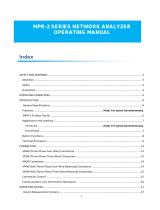
PQ3350-en-GB_V5.7 5/17
a. Setup the analyzer for measurement of any power system (3P4W, 3P3W, 1P2W, or 1P3W). To view the
harmonic analysis of voltage or current, press the
button.
b. Once the button is pressed, the waveform will be shown in the left-hand portion of the LCD, and the 1
st
to 50
th
order harmonics will be shown in the right-hand portion of the LCD.
c. The positive and negative peak values will be shown in the waveform (Vpk).
d. The true RMS value & total harmonic distortion of voltage or current is shown under the waveform.
e. The cursor (
↑
arrow) will point to the current order of harmonics. The frequency (HZ) will be displayed next to the
cursor. The percentage of harmonics (%) will be displayed below the cursor. The magnitude of the harmonics
(V or A) or phase angle will be displayed next to the %.
f. Press the VI button to change to the various inputs (V1, I1, V2, I2, V3, I3)
g. If the wave form is too small or clipped, press the RANGE button to change ranges.
h. To move the cursor to the next harmonic, use the ◄or ► button.
i. To see the next page (51
st
to 99
th
order) press the ► button to pass the 50
th
order or press the ◄ button to pass
the 1
st
order.
NOTE: If the waveform is clipped at the peak or too small in the LCD, press the RANGE button to select HIGH or
LOW range for a better display. The range indicator is the symbol after the unit of RMS value, L or H.
Display the Phase Angle of Harmonics
When the button is pressed the magnitude of each harmonic is displayed. To review the phase angle of
each harmonic, press the PHASE button. The phase angle will be displayed next to the % display icon. V1 does
not trigger at exactly 0 degrees; it may be a few degrees after ‘0’. The remaining signals (V2, V3, I1, I2, I3) are
sampled when V1 is triggered. In other words, the phase angles for V2, V3, I1, I2, and I3 are sampled with respect to
V1. For example, if V1, I1 have a phase difference of 30 degrees, they are displayed as V1 (2 degrees), I1 (32
degrees) in the harmonics analysis.






















